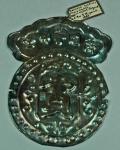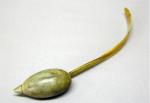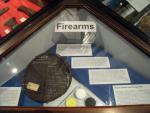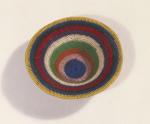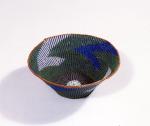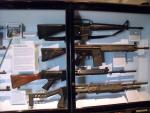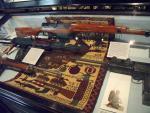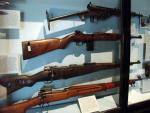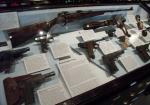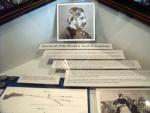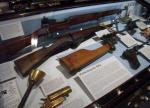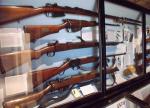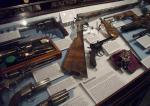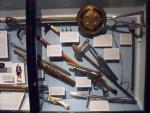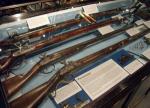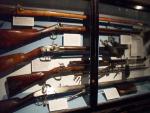
helen
For Deletion-
Posts
166 -
Joined
-
Last visited
Content Type
Profiles
Forums
Blogs
Gallery
Events
Store
Everything posted by helen
-
hi vonmesser - yes, the 'natural' methods of procuring nitrate sounded rather more cumbersome and unpleasant than just popping over to the chemistry department! Mervyn - no explosions as yet, and these displays were installed two years ago. We have a black powder box tucked away in the stores which we keep an eye on too! Kev - no, no 'don't try this at home' warnings - we are not obliged to legally, and the information regarding ingredients is out there online / in print etc anyway if they're really that keen to try blowing themselves up! Helen
-
HOW WE USED TO SHAVE....
helen replied to Mervyn Mitton's topic in Non Military Collectibles & Antiques
Lovely little shaving jug. I'm not in a position to comment about the death-defying feat that is a man's cut-throat razor shave (female shaving and eyebrow tweezering and so on are hazardous enough!). However, thought I might take the opportunity to point out this page on a new website I've created looking at objects from the Pitt Rivers Museum's collections used for decorating, styling, grooming and modifying the body. These razors date to the 19th century and give a nice idea of what might have accompanied this jug in a gentleman's 'toilet'. Helen -
Lovely piece! I am not an expert on these things. I know I've seen a Weller piece in the V&A (I used to volunteer in their ceramics department), a jardiniere, of similar dark glaze lustre and finish. That piece is dated to the very early C20th, as Brian suggests this might well be. After checking up on it in their catalogue, it is labelled 'Aurelian ware', a variation of Louwelsa in which the background colour was applied by hand with a brush rather than with a sprayer/atomizer. My guess is this would render it more valuable than the mass-produced stuff. Is the bird painted or 'scratched' (i.e. sgraffito'd) on? Can't really tell from the image. Seems the 'scratched' items are rarer too, as it was a pretty labour-intensive process and Weller soon switched over to embossing which replicated the effect at lower cost. That last bit of info is from this quick History of Weller Pottery here. Something else of interest that it points out is that the name 'Louwelsa' is derived from a combination of Weller's name with that of his new-born daughter, Louise. Had a quick look on auction sites (not eBay) and these sorts of pieces seem to be going for at least 300 USD. Thanks for sharing. Helen
-
Necklet of wooden beads believed to be called 'iziqu zomnyezane' and presented to Zulu warriors as an award for valour. This one collected c. 1879 by James Andrew Kennedy whose estate was in Victoria County and said to be 'a pioneer in Natal' although I can't find out anything about him! Helen
-
The beaded items are really beautiful...
-
Hello, Can anyone help identify this item? Think it may be one of the animal Manchu silver badges I've heard about but I know nothing of Chinese military insignia, nor can I really make out the creature in the centre (if it is a creature!) It was collected in China by one Major-General Rigaud sometime before 1887. His regiment, the Kings Royal Rifle Corps took part in the Opium Wars of 1850s so there's a chance it was picked up then? Any information whatsoever would be much appreciated. With thanks, Helen
-
Splendid information as always Mervyn, thank you! Interesting to learn that it may be something of a rare item...perhaps I ought to let our auditor know! I did wonder how it might have been carried (tucked in a waistband or suspended from the neck, etc.) so now I know it would have been carried in the hair. Best, H
-
hi to all, Apologies for a rather long absence from the forum! Here is something for this thread (not a weapon I'm afraid, sorry), but I would be interested if anyone has anything to say about it. I think it is a type of strigil (sweat scraper), made of horn, with a little snuff box perched on top. It's beautifully made. C19th, not sure from where. Nguni-speaking people but not necessarily Zulu. I've seen Zulu knobkerries with snuff boxes incorporated into the handles so this concept would seem fitting! Mervyn - any thoughts? Best, Helen
-
Interesting and a great object to call one's own. Thanks for sharing!
-
hi, well the charcoal was easy, and managed to palm some potassium nitrate from the local university chemistry department. We were advised by conservationists that the sulphur might deteriorate and 'leak' vapour over time (even though the substances are in sealed crystal boxes, no doubt some gas will escape over the course of several years) so in the end we got some bright yellow chalk and crushed it down into powder - it looked a fairly good match and it was just to give folks an impression. I wouldn't think about trying to mix my own gunpowder as I've heard it's very tricky to get the amounts right! Thanks for all your comments. Helen
-
The first weapon is what I believe collectors term a 'Wahhabi jambiya' a type of jambiya originating in the Asir, Hejaz, Nejd (generally the South, West and Central Saudi Arabia and Yemen border) and so-called after its use by the followers of Muhammed ibn Abdul Wahhab from the C18th onwards. Locally they are known by vernacular names ('sabak', 'sabiaki', etc). Seen some go for sale in internet for 450 USD and upwards, depending on age and quality. The second dagger is a Moroccan koummya. These weapons are interesting in that aspects of their design are intended to ward off the evil eye. The curved blade imitates the curved boar's tusk, an animal that responds aggressively if threatened. The commonly seen fretwork on the scabbard is often made so that it creates eye-like gaps and crosses with five points, corresponding the five fingers on the protective Hand of Fatimah. The belt holes look very 'fresh' which suggests the dagger has not been well used. On historical examples, these holes are often worn quite large and uneven by the baldric. As Mervyn pointed out, the blade does not seem in as good shape as the first example. Also, is the scabbard fully decorated on one side or both? If both, it is more likely to be a later, 'souvenir' item as many authentic koummya scabbards were only fully decorated on the side 'on show' to the world when the weapon was sheathed at the hip. Sword Forum International (www.swordforum.com) are bound to have a thread or two on these types of weapons so might be worth checking that out. Plenty of info on koummyas on the web. For Arabian weapons, try Robert Elgood's very good book 'Arms and Armour of Arabia in the C18th-20th' - if you don't want to buy it, you can probably read snippets via keyword searches on Google books. May not help you with valuations but will give you some historical background if you desire it. Helen
-
Thanks for the added bit of history about the miners Mervyn, that's really interesting. I will try to incorporate it into the information we give to visitors. Cheers!
-
Mervyn - nice story about the King's opinion of the statue! My post has nothing to do with weapons but is about some Zulu items that fascinate me nonetheless! Colourful telephone wire baskets. I assume they're still being made in S.Africa (presumably as tourist items?) but I am not sure about this. These ones came to the Pitt Rivers Museum in Oxford about 10 years ago. I don't know of any others in museum collections in Britain but of course there may well be. I've included them in the new audio guide for museum visitors with the following information: These brightly coloured baskets,made out of telephone wire, were bought in the Mai Mai Zulu market in Johannesburg in the 1990s. Basket makers all around the world, particularly inthe less developed countries of Africa, Asia, and South America, recycle the waste products from developed countries in extraordinarily clever, creative andbeautiful ways. Baskets that were once made out of grass, leaves or bark are now being made out of plastic, foil, rubber and other modern materials. Zulu wire baskets are a good example of a time-honoured craft surviving and adapting to changing social conditions. Zulu baskets were traditionally made out of palm leaf and grass. Many bulb-shaped baskets such as this were made by the coiling method, borrowed from coil pottery and the weaving is so tight that they are used as containers for beer. Beer, derived from sorghum, was an important part of daily life, as well as being drunk at ceremonies such as weddings, funerals and harvest parties. Beer can also serve as a votive offering to ancestral spirits,and the beer basket itself was an important symbol of hospitality. These modern baskets are known as imbenge, upside-down beer-pot covers. This is to protect the liquidfrom insects and evil spells. Just as with the original fibre versions, most imbenge have a loop with which to hang it up when not in use. It can also be used as a bowl to serve maize or porridge, or simply as a table centerpiece. It is not known who made or donated this basket, but what is interesting is that outin the villages, basket-work was mainly done by women, but the telephone wire versions were first done by men. The tale goes like this: In the early 1990s, some SouthAfrican men who had moved to towns and cities such as Johannesburg and Durban,found work as night watchmen. They recognized the potential offered bydiscarded multi-coloured telephone wire lying about in the buildings they wereguarding. With time on their hands, knowledge of traditional basket techniques,and a new brightly coloured material, they invented a stunning new art form.The shape and form of the baskets are traditional but the new, thin, springy material did not lend itself to the coiling method so they developed a newspiraling technique instead that unusually worked from the outside in towardsthe centre, and perfectly exploited the myriad of colours. The craft was soontaken up by women and neighbouring communities in Zimbabwe, and became avaluable source of income for the indigenous people living in urban areas. Technical developments such as fibre-optics and mobile and cordless phones inthe 1990s led to a shortage of telephone wire that threatened to end thisvibrant new art form. However, with additional financial support from the South African government and the national telecommunications company, artists continue to be supplied with the raw materials they need. In fact, the practicehas spread out of the cities and into rural cooperatives, where men injured working in the mines and oil fields are taught how to weave the baskets.
-
I'm sorry Mark, all this unexpected sunshine in the UK at the moment has gone to my head! Wewe DON'T have a Bren (it would be on display if we had!) But I think it was in my mind because it's on a list of 'desirables' I'm drawing up - guns it'd be really nice to get for the collection. The list includes a Winchester too! So in terms of 'big guns' nothing on that power scale - instead just a couple of sub-machine guns (e.g. Sten, UZI) and battle rifles (H&K, FN FAL). Helen
-
Hi Mark, No machine guns - sorry! We've had a policy ofnot collecting any large small arms or artillery, due our space restrictions,both in terms of storage and display (our display cases are at best a footdeep). The biggest thing we have is a Bren (although we have some very long duck guns and some heavy medieval hand cannon!) The General was born Augustus Lane Fox in 1827 (he acquired the title and estates of 'Pitt Rivers' in 1880). As a captain in the Grenadier Guards, he was appointed in 1851 to a committee set up byWellington (then Commander in Chief) to experiment and report on various newrifled infantry weapons to find a replacement for the Brown Bess. Lord Hardingetook over the role of C-i-C in 1852 and another Grenadier, Studholme Brownrigg (great name!) was president of the committee. From 1851, Fox began to collect all sorts of guns from all over to take them apart and see how they worked. He even had prototype models made up for him, including a musket with a revolving chamber, a breech-loading rifle with a version of Dreyse's bolt-action (which had only really been introduced in Prussia a few years before in the late 1840s) and guns with experimental, adjustable sights. In fact, he was more interested in projectiles than mechanisms and did a lot of work testing the various new ideas. See attached image from his talk, 'On the Improvement of the Rifle as a Weapon for General Use' given at the Royal Service Institution in1858. He was an advocate of the Minie bullet design, which was what the Army eventually adopted for the Pattern 1853 Rifled Musket Enfield. We have a prototype of the P53 made for Fox. Fox was sent to study the modes of weapons training used in France and Belgium and draw up a code of instruction. His 'Instruction of Musketry' was implemented at the new School of Musketry set up at Hythe in Kent in 1853 and Fox became principal instructor there under Colonel Hay. During the Crimean War, Fox was dispatched to Bulgaria and Malta to conduct training inthe field but we have no record of whether he actually saw any action himself. We know he was involved with the Battle of Alma. He was shipped back home on grounds of poor health before the end of the war. He fell out with Hay at Hythe so resumed rifle training in Malta 1855-57, whereupon he was promoted to Lieutenant-Colonel. In the 1860s he was posted as Assistant Quartermaster General in Canada and Ireland. By this time he had amassed an impressive array of guns from all eras and areas and had also moved into collecting other weapons such as bows, shields, throwing knives, swords etc, as well as other ethnographic items. He was determined to apply Darwin's theory (then all the rage) to material culture, by charting the development of man-made objects from the 'primitive' (according to Fox, found among the native peoples of Africa, Australia and N. America) to the 'civilized' (unsurprisingly, those items madeby white, European men!) His ideas concerning evolution of culture weren't entirely wrong (indeed in firearms, a traceable line of development is quite clear) but he couched his arguments in such as way that is now considered redundant and politically incorrect. He wasn't much of a 'field collector' though – got most of his stuff from auction or more itinerant associates at the RoyalSociety etc. He retired in 1882 with honorary rank of Lieutenant-General and turned his attention to archaeology. He died in 1900. We have 155 firearms and accessories attributed to Pitt Rivers and a further 5000 weapons – over a quarter of his 'Founding Collection' given to us in 1884. Obviously a great deal many more firearms have been added to the collections since then (over 1500). Hope that suffices! There's an entry on him on Wikipedia but it doesn't elaborate much on his military life. Helen
-
Thanks Eric and Douglas for the nice comments. Yes, there was some discussion about the schema of display - some thought that chronological was far too boring and ordinary but I don't really see how you can follow the progression any other way. In the end in fact, there was a bit of date mixing by putting the objects in sub-divisions based on their firing mechanism - the matchlock muskets included C16th English examples as well as C19th ones from Asia. Helen
-
-
Sorry for some of the hazy visuals on these photos -if only we could afford non-reflective glass! Mervyn - thanks for your comments! Sadly, I'm not sure our expenses could stretch to a ticket from SA but please do let me know if you want to know anything more about a particular object. And yes, I am officially working on something else now (sadly not to do with weapons) but hopefully I will finally be able to get around to your truncheons! As for the 'Greek fire bomb' you are right about how it works - usually filled with some bitumen-, petrol- or sulphur-based mixture I believe and a small hole with a fuse. Ours was discovered in a rubbish dump at Fustat, which was Byzantine captial of Egypt until 1168. So, it might have been among those used against the Arab incursions in 639 or, more likely, much later against Saladin in the 1160s before the city was abandoned. Best, Helen
-
-
-
-
-



